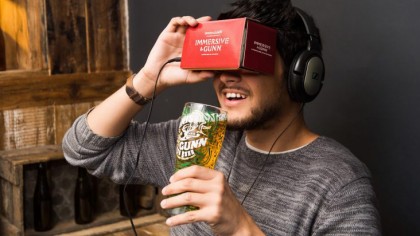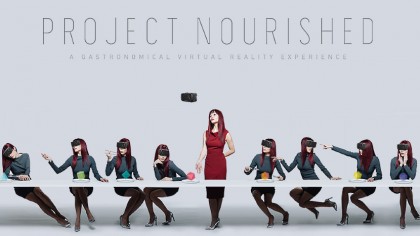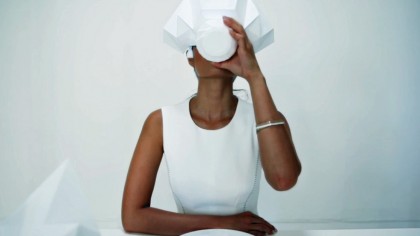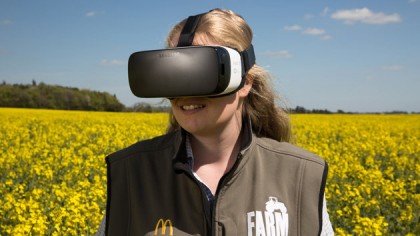How VR is helping transform the way we eat and drink
Virtual beer, anyone?
As the experience is so new, it's currently only available in Scotland, in Edinburgh and Dundee, although the brewer plans to expand it to London and Glasgow within the next few weeks. Dougal Gunn Sharp, master brewer and founder of Innis & Gunn, is a big believer in the tech.
He says: "The surroundings in a pub setting are all quite similar, so our taste buds already have a memory attached to them and as a result an expectation of the taste experience.

"By taking people into a virtual reality world, all the typical sights, sounds and smells are removed so that we're more open to detecting new tastes and aromas, and find a new way to perceive beer. There's a social aspect to this too as people try our virtual reality experience, and they end up comparing the flavours and aromas with others."
Virtual food
Virtual reality is also being used to create new food tasting experiences. Project Nourished, developed by LA-based technology think tank Kokiri Lab, is a gastronomical VR experience that lets you enjoy your favourite meals without consuming calories. All your senses - taste, smell and touch - are maintained.

It uses an Oculus Rift headset, cutlery equipped with sensors, aromatic diffusers and low-calorie food. The idea is that you eat healthy food, but your brain thinks it's a heavy meal. These non-fatty substitutes - including agar, gum arabic and konjac jelly - can mimic steak, pies, sushi, burger and lasagne dishes.
Just like the beer experience, the virtual reality headset takes you to real-life locations of your choosing. And a gyroscopic device lets you eat the food in these different places. Aromatic diffusions allow you to smell the food as you're about to eat it.
Jason Kingsley OBE, CEO at games developer Rebellion, says projects like Project Nourished show that VR has lots of potential in the food sector. Despite the interest they're attracting, though, Kingsley insists that VR will never be able to replace food fully. Instead, VR will act as a visual component and stimulant.
Get daily insight, inspiration and deals in your inbox
Sign up for breaking news, reviews, opinion, top tech deals, and more.

He says: "We are already seeing the food industry taking its first steps into the VR arena – from McDonalds' use of 360-degree video for its Follow our Foodsteps campaign allowing viewers to see how the food is prepared to the downright bizarre Project Nourished, which claims to simulate eating for a guilt-free, calorie-free dining experience.
"VR will be hugely successful at creating visual experiences. When it comes to taste, however, there can be no substitute for experiencing food the old-fashioned way – no matter how sophisticated the technology becomes, it seems unlikely that aromatic diffusers and gyroscopic utensils will ever come close to the real thing."

New restaurant experiences
Samsung, too, is exploring ways VR can impact food. It's been working on a series of restaurant experiences for the Gear VR. The company envisages the headset letting you dine undersea or at a rural hillside in Italy, all while you dine from home or at a budget hotel.
Writing in a blog post, the company says venues can set themselves apart by implementing new technology.
"By integrating virtual reality technology into your restaurant even on a less ambitious scale, you will quickly stand out from the crowd both with the innovative technology and the unique experience that highlights your cuisine. This is something that will help draw in new customers, and keep loyal customers coming back to try something new," the company writes.
Will McMaster, from VR development studio Visualise, is more sceptical. He says that while great strides are being made in the area, the hardware needs to improve. "For VR food experiences to really work, a lot of evolving needs to happen to both the headset and tracking technology," he tells us.
"Right now, it's cumbersome to eat anything with a VR headset on due to their size and limited field of view, and VR tracking technology can't precisely track your hands, so you can't see what you are actually putting on your fork to put it into your mouth."
Virtual reality is an exciting area, and it's clearly garnering interest in the food and drink industry. For hospitality organisations, it's a way to improve customer experiences and show they're keeping up-to-date with the latest technology. And for consumers, it means tastier food.
The potential is limitless here, and we'll no doubt see improved experiences in the future as the tech continues to advance.
Nicholas Fearn is a freelance technology journalist and copywriter from the Welsh valleys. His work has appeared in publications such as the FT, the Independent, the Daily Telegraph, The Next Web, T3, Android Central, Computer Weekly, and many others. He also happens to be a diehard Mariah Carey fan!